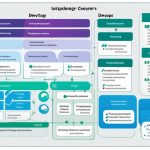Cloud-native application development requires fast and efficient deployment to stay competitive in the tech market. Automation is the solution to this challenge. In this article, we will explore the top cloud deployment tools that help streamline cloud deployments and maximize the use of management tools.
By leveraging these cloud deployment management tools, organizations can accelerate production, ensure consistency, and optimize resource utilization. With automation at the forefront, these tools simplify infrastructure provisioning, deliver compliance, and provide centralized management consoles for seamless cloud operations.
Join us as we dive into the features and benefits of each tool, including DuploCloud, AWS CloudFormation, Google Cloud Deployment Manager, Microsoft Azure Automation, Terraform, Chef Automate, Puppet Enterprise, and Red Hat Ansible Automation Platform. Whether you’re an IT professional, DevOps specialist, or cloud enthusiast, this comprehensive guide will equip you with the knowledge and insights to make informed decisions when it comes to streamlining your cloud deployments.
DuploCloud: Automating Cloud Configurations
DuploCloud is an innovative, no-code/low-code DevOps-as-service platform that revolutionizes cloud automation and application lifecycle management. With DuploCloud, organizations can seamlessly transform high-level application specifications into detailed, secure, compliant, and fully managed cloud configurations.
What sets DuploCloud apart is its comprehensive provisioning capabilities, enabling deployments across AWS, Azure, and GCP environments. This flexibility empowers businesses with the freedom to choose their preferred cloud provider while leveraging the power of automation.
Automation is at the core of DuploCloud’s capabilities. Leveraging modern technologies such as containers, serverless deployments, and ETL pipeline automation, DuploCloud allows organizations to streamline their cloud configurations and eliminate manual errors. By automating tasks ranging from disaster recovery to password management and single sign-on, DuploCloud enhances security and efficiency across the application lifecycle.
Furthermore, DuploCloud ensures compliance with industry-standard frameworks, providing peace of mind to organizations operating in regulated industries. Its compliance-first approach allows businesses to meet regulatory requirements without compromising on speed or agility.
Another standout feature of DuploCloud is its robust application lifecycle management capabilities. The platform offers full visibility into cloud actions, allowing organizations to monitor and optimize their cloud resources effectively. With DuploCloud, businesses can effortlessly track and manage cloud deployments, ensuring efficient resource utilization.
DuploCloud has gained traction among IT professionals who praise its user-friendly, no-code UI that simplifies automation initiatives. With its compliance-first approach and comprehensive feature set, DuploCloud emerges as a leading solution in the cloud automation landscape.
To summarize, DuploCloud empowers organizations with cloud automation capabilities, enabling them to streamline their configurations, enhance security, ensure compliance, and optimize resource utilization. With positive reviews from IT professionals, DuploCloud stands as a reliable solution for businesses looking to maximize the benefits of cloud automation and application lifecycle management.
| Key Features | Benefits |
|---|---|
| Comprehensive provisioning capabilities | Deploy across AWS, Azure, and GCP environments |
| Automation through containers, serverless deployments, and ETL pipeline automation | Enhanced security and elimination of manual errors |
| Disaster recovery, password management, single sign-on, and just-in-time access | Improved operational efficiency and control |
| Meeting industry-standard compliance frameworks | Peace of mind in regulated industries |
| Comprehensive application lifecycle management and visibility into cloud actions | Efficient resource utilization and optimization |
AWS CloudFormation: Streamlined Infrastructure Provisioning
AWS CloudFormation is a powerful cloud automation platform that facilitates the modeling, provisioning, and management of AWS resources and third-party applications across all regions and accounts. This tool offers automated provisioning and infrastructure updates, ensuring efficient deployment and maintenance processes.
With AWS CloudFormation, developers can leverage change set previews to preview and confirm any modifications before implementing them. This feature enhances the ability to iterate easily during development and ensures that infrastructure updates are carefully validated.
A key advantage of AWS CloudFormation is its support for asynchronous replication, failback, failover, and IAM (Identity and Access Management). These capabilities provide developers with the necessary flexibility and control over their cloud infrastructure.
To streamline the management process, AWS CloudFormation provides a centralized management console. This console simplifies the task of monitoring and managing the provisioned resources, giving users a comprehensive view of their entire infrastructure.
AWS CloudFormation is widely regarded as one of the top cloud automation tools for AWS development environments. Its versatility and user-friendly interface empower developers to quickly create and build comprehensive infrastructures and provision resources within minutes.
Through automated provisioning, infrastructure updates, and a centralized management console, AWS CloudFormation offers a streamlined and efficient approach to infrastructure automation in an AWS environment.
Benefits of AWS CloudFormation:
- Streamlined infrastructure provisioning
- Efficient management of AWS resources
- Support for change set previews
- Asynchronous replication, failback, and failover
- Enhanced IAM support
- Centralized management console
In summary, AWS CloudFormation enables developers to automate their infrastructure provisioning, ensuring faster and more reliable deployments. Its comprehensive features, such as change set previews and centralized management, make it a valuable tool for achieving infrastructure automation in AWS environments.
| Feature | Benefits |
|---|---|
| Automated provisioning | Accelerated deployment and consistent configuration |
| Change set previews | Confidence in infrastructure updates before implementation |
| Asynchronous replication, failback, and failover | High availability and disaster recovery capabilities |
| IAM support | Security and access control for AWS resources |
| Centralized management console | Efficient monitoring and management of provisioned resources |
Google Cloud Deployment Manager: Simplifying Google Cloud Resources
When it comes to streamlining cloud deployments in Google Cloud, the Google Cloud Deployment Manager is an essential tool. This powerful resource offers deployment automation and comprehensive resource management, making it an ideal choice for DevOps teams looking to optimize their workflows.
One of the standout features of Google Cloud Deployment Manager is its strong focus on IAM support. With IAM (Identity and Access Management), users have fine-grained control over access to resources, ensuring that the right individuals have the appropriate permissions. This level of security support is crucial in ensuring that cloud resources are protected.
Additionally, Google Cloud Deployment Manager complies with industry standards, giving organizations peace of mind when it comes to regulatory requirements. The platform offers a centralized deployment management console, providing a clear and organized view of all deployments.
DevOps teams particularly appreciate the declarative syntax and templatization offered by the Deployment Manager. This allows for efficient and repeatable deployments, saving time and effort. The hierarchical view further enhances the user experience by providing a structured overview of all deployments.
With Google Cloud Deployment Manager, deploying and managing Google Cloud resources has never been easier. Its support for IAM, compliance with industry standards, and efficient deployment automation make it an invaluable tool for organizations looking to streamline their cloud operations.
Take a look at the table below for a summary of Google Cloud Deployment Manager’s key features:
| Key Features | Description |
|---|---|
| IAM Support | Granular control over resource access |
| Compliance | Meets industry standards and regulatory requirements |
| Centralized Management | Clear view of all deployments |
| Declarative Syntax | Efficient and repeatable deployments |

With Google Cloud Deployment Manager, organizations can simplify the management of Google Cloud resources and enjoy the benefits of deployment automation, IAM support, and compliance with industry standards. Whether you’re deploying a single application or managing a complex infrastructure, Google Cloud Deployment Manager is a powerful tool that can streamline your cloud operations.
Microsoft Azure Automation: Orchestrating Deployments
Microsoft Azure Automation is a powerful cloud automation platform that allows DevOps teams to efficiently manage automation and configurations across deployments in Azure, on-premises, and third-party environments. With its robust features, Azure Automation enables seamless deployment orchestration, fulfillment delivery automation, continuous delivery automation, and replication and failover support. It provides native security capabilities, compliance and configuration monitoring, and an intuitive automation management console.
Azure Automation simplifies the deployment process by automating repetitive tasks and streamlining complex workflows. DevOps teams can easily create runbooks using PowerShell or Python scripts, eliminating the need for manual intervention and reducing human error. By standardizing deployment processes through Azure Automation, organizations can achieve consistent results and accelerate their time to market.
One of the key advantages of Microsoft Azure Automation is its comprehensive compliance monitoring capabilities. It helps organizations ensure that their deployments adhere to regulatory requirements and industry standards. By continuously monitoring compliance, Azure Automation provides insights into potential risks and vulnerabilities, allowing teams to proactively address any issues. This proactive approach helps organizations maintain a secure and compliant cloud environment.
“Azure Automation simplifies the deployment process by automating repetitive tasks and streamlining complex workflows.”
Additionally, Azure Automation offers an easy-to-use process management interface that allows DevOps teams to monitor and manage their automation processes efficiently. It provides real-time visibility into the status of deployments, enabling teams to track progress and troubleshoot any issues that may arise. The automation management console in Azure Automation offers a user-friendly experience, making it accessible to both technical and non-technical users.
The Benefits of Microsoft Azure Automation:
- Streamlines deployment processes through automation
- Reduces manual intervention and human error
- Enables consistent and repeatable deployments
- Provides comprehensive compliance monitoring
- Ensures adherence to regulatory requirements and industry standards
- Offers real-time visibility and process management capabilities
To illustrate the value of Microsoft Azure Automation, let’s take a closer look at the following table:
| Cloud Automation Platform | Deployment Orchestration | Compliance Monitoring |
|---|---|---|
| Microsoft Azure Automation | Yes | |
| DuploCloud | No | No |
| AWS CloudFormation | Yes | No |
In the table above, we can see that Microsoft Azure Automation stands out as a cloud automation platform that excels in deployment orchestration and compliance monitoring. While other platforms may offer deployment orchestration or compliance monitoring individually, Azure Automation combines both capabilities, providing a comprehensive solution for organizations.
Terraform: Rapid Cloud Infrastructure Deployment
Terraform is an open-source cloud infrastructure automation tool that enables DevOps teams to rapidly deploy and optimize infrastructure across any cloud environment. With its plug-in-based infrastructure provisioning and comprehensive capabilities, Terraform simplifies the process of creating and managing infrastructure resources.
One of the key features of Terraform is its infrastructure automation through existing workflows. It allows users to define their desired infrastructure configuration using a declarative language, which can be versioned and stored in a code repository. This approach enables IT professionals to treat infrastructure as code, providing the ability to automate infrastructure changes, enforce policies, and promote collaboration across teams.
Terraform also offers cloud agnostic support, allowing users to provision infrastructure on multiple cloud platforms such as AWS, Azure, and Google Cloud. This agnosticism provides flexibility and avoids vendor lock-in, enabling organizations to adopt a multi-cloud strategy or seamlessly migrate between cloud providers as needed.
IT professionals highly rate Terraform for its ability to provision infrastructure as code and the ease of use it offers in creating or updating resources on various cloud platforms. The flexibility, scalability, and efficiency provided by Terraform make it an invaluable tool for streamlining cloud infrastructure deployment.
| Key Features | Benefits |
|---|---|
| Plug-in-based infrastructure provisioning | Simplifies the creation and management of infrastructure resources |
| Comprehensive provisioning capabilities | Enables automation and scalability of infrastructure changes |
| Infrastructure automation through existing workflows | Streamlines the deployment and management of infrastructure |
| Policy as code enforcement | Enables consistent and compliant infrastructure configurations |
| Cloud agnostic support | Provides flexibility and avoids vendor lock-in |
Red Hat Ansible Automation Platform: Scaling Automation Usage
The Red Hat Ansible Automation Platform is an enterprise-grade solution that combines Ansible Automation, Ansible Tower, Ansible Engine, and other components to help IT teams scale automation usage across their organizations.
Using easy-to-understand playbooks, the platform allows for efficient configuration and deployment. It also offers backup and restore support, ensuring data integrity throughout the automation process. Additionally, role-based access control provides enhanced security measures, while predictive threat detection helps identify and mitigate potential risks.
With the Red Hat Ansible Automation Platform, organizations can meet regulatory and procurement standards, thanks to its comprehensive features. The web-based centralized management console offers a user-friendly interface for seamless control and oversight of automation activities. It provides full visibility into usage, uptime, and deployment status, enabling IT teams to make informed decisions and optimize their automation workflows.
As a trusted solution in the industry, Ansible Automation is known for its ease of use and powerful automation capabilities. It has become a popular choice for organizations looking to streamline their cloud deployments and maximize efficiency.
FAQ
What is DuploCloud?
DuploCloud is a no-code/low-code DevOps-as-service platform that automates cloud configurations and provides comprehensive provisioning capabilities.
Which cloud environments does DuploCloud deploy across?
DuploCloud deploys across AWS, Azure, and GCP environments.
What are the key features of DuploCloud?
DuploCloud offers automation through containers, serverless deployments, and ETL pipeline automation. It also ensures disaster recovery, password management, single sign-on, and just-in-time access into applications.
How does DuploCloud help with compliance?
DuploCloud deploys applications that meet industry-standard compliance frameworks and provides comprehensive application lifecycle management.
What do IT professionals appreciate about DuploCloud?
IT professionals appreciate DuploCloud’s no-code UI and its ability to automate initiatives with a compliance-first approach.
What is AWS CloudFormation?
AWS CloudFormation is a cloud automation platform that models, provisions, and manages AWS resources and third-party applications.
What does AWS CloudFormation support?
AWS CloudFormation supports automated provisioning, infrastructure updates, change set previews, asynchronous replication, failback, failover, and IAM.
What is the benefit of using AWS CloudFormation?
AWS CloudFormation allows for the creation and build of entire infrastructure setups and resource provisioning within minutes.
What is Google Cloud Deployment Manager?
Google Cloud Deployment Manager is Google’s equivalent to AWS CloudFormation and offers deployment automation and resource management for Google Cloud resources.
What are the key features of Google Cloud Deployment Manager?
Google Cloud Deployment Manager provides comprehensive IAM and security support, complies with industry standards, and offers a centralized deployment management console.
What is Microsoft Azure Automation?
Microsoft Azure Automation allows for the management of automation and configurations across deployments in Azure, on-premises, and third-party environments.
What are the capabilities of Microsoft Azure Automation?
Microsoft Azure Automation offers deployment orchestration, fulfillment delivery automation, continuous delivery automation, and replication and failover support.
What is the benefit of using Microsoft Azure Automation?
Microsoft Azure Automation provides native security support, compliance and configuration monitoring, and an automation management console.
What is Terraform?
Terraform is an open-source cloud infrastructure automation tool that allows for the rapid deployment and optimization of infrastructure across any cloud environment.
What are the key features of Terraform?
Terraform offers plug-in-based infrastructure provisioning, comprehensive provisioning capabilities, infrastructure automation through existing workflows, policy as code enforcement, and cloud agnostic support.
What is the Red Hat Ansible Automation Platform?
The Red Hat Ansible Automation Platform is an enterprise-grade solution that combines Ansible Automation, Ansible Tower, Ansible Engine, and other components to help IT teams scale automation usage across their organizations.
What does the Red Hat Ansible Automation Platform provide?
The Red Hat Ansible Automation Platform provides easy-to-understand playbooks for configuration and deployment, backup and restore support, role-based access control, predictive threat detection, regulatory and procurement compliance, and a web-based centralized management console.
What are the benefits of using the Red Hat Ansible Automation Platform?
The Red Hat Ansible Automation Platform offers ease of use and powerful automation capabilities, making it a popular choice for cloud deployments.



















